
The Ford Laser is a compact car, originally a subcompact car in the first three generations, which was sold by Ford in Asia, Oceania, and parts of South America and Africa. It has generally been available as a sedan or hatchback, although convertible, wagon and pick-up versions have also been available in different markets. The sedan, and briefly station wagon, versions were badged Ford Meteor in Australia between 1981 and 1987. The Ford Meteor name was also used in South Africa.

The Volkswagen Polo is a supermini car (B-segment) produced by the German car manufacturer Volkswagen since 1975. It is sold in Europe and other markets worldwide in hatchback, saloon, and estate variants throughout its production run.

The Citroën Visa is a five-door, front-engine, front wheel drive supermini manufactured and marketed by Citroën from 1978 to 1988 in gasoline and diesel variants. 1,254,390 examples were ultimately manufactured over a single generation, with a single facelift (1981). China has also assembled the car as the Liuzhou Wuling LZW 7100 minicar. Production started in 1991 and finished in 1994.

The Peugeot 504 is a mid-size, front-engine, rear-wheel-drive automobile manufactured and marketed by Peugeot from 1968 to 1983 over a single generation, primarily in four-door sedan and wagon configurations – but also as twin two-door coupé and cabriolet configurations as well as pickup truck variants.

The Citroën LN (Hélène) and Citroën LNA (Hélèna) are front-engine, front-drive, three-door, four passenger hatchback city cars manufactured and marketed by Citroën from 1976-1986 over a single generation — as a badge engineered variant of the Peugeot 104, introduced shortly after the takeover of Citroen by Peugeot.
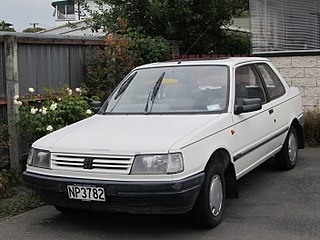
The Peugeot 309 is a small family car that was manufactured between 1985 and 1994 in England, Spain and France by PSA Peugeot Citroën. It was originally intended to be badged as a Talbot and, as development progressed, to be called the Talbot Arizona.

The Hillman Avenger is a rear-wheel drive small family car originally manufactured by the former Rootes division of Chrysler Europe from 1970–1978, badged from 1976 onward as the Chrysler Avenger. Between 1979 and 1981 it was manufactured by PSA Peugeot Citroën and badged as the Talbot Avenger. The Avenger was marketed in North America as the Plymouth Cricket and was the first Plymouth to have a four-cylinder engine since the 1932 Plymouth Model PB was discontinued.
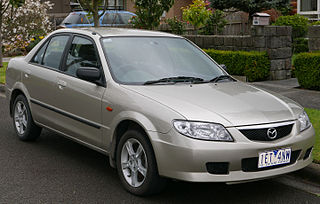
The Mazda Familia, also marketed prominently as the Mazda 323, Mazda Protegé and Mazda Allegro, is a small family car that was manufactured by Mazda between 1963 and 2003. The Familia line was replaced by the Mazda3/Axela for 2004.

The Peugeot 307 is a small family car produced by the French automaker PSA Peugeot Citroën, under their Peugeot marque, from 2001 to 2008 in Europe, and was the successor to the Peugeot 306, which was discontinued in 2002 after being in production for nine years. Using the PSA PF2 platform, it was awarded the European Car of the Year title for 2002, and continued to be offered in China and certain South American markets through 2014, despite the September 2007 French launch of the 308, which is built on the same platform.
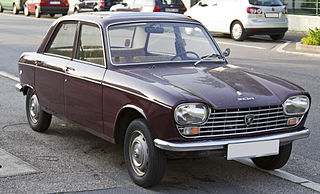
The Peugeot 204 is a small family car produced by the French manufacturer Peugeot between 1965 and 1976.
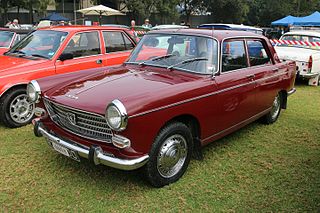
The Peugeot 404 is a large family car produced by French automobile manufacturer Peugeot from 1960 to 1975. A truck body style variant was marketed until 1988. Styled by Pininfarina, the 404 was offered initially as a saloon, estate, and pickup. A convertible was added in 1962, and a coupé in 1963. The 404 was fitted with a 1.6 litre petrol engine, with either a Solex carburetor or Kugelfischer mechanical fuel injection or a 1.9 litre diesel engine available as options. Introduced at the Paris Motor Show as an option was the inclusion of a 3-speed ZF automatic transmission, similar to the unit already offered on certain BMW models, as an alternative to the standard column-mounted manual unit.
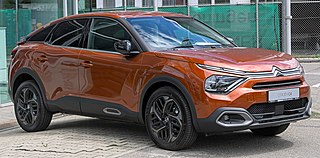
The Citroën C4 is a car produced under their Citroën marque, from the French automaker PSA Group, and later Stellantis. It was positioned to be the successor to the Citroën Xsara. The first generation production started in September 2004. For its first two generations, the Xsara was a compact car/small family car, but it has been redesigned as a subcompact crossover SUV for its third generation.

The Renault 16 (R16) is a D-segment family hatchback produced by French automaker Renault between 1965 and 1980 in Le Havre, France. The Renault 16 was the first French winner of the European Car of the Year award.

The Citroën C15 is a panel van produced by the French manufacturer Citroën from late 1984 until 2006. It was the successor to the Citroën Acadiane, which had replaced the Citroën 2CV vans that pioneered the box van format from the 1950s to the 1970s, although the Acadiane continued in production alongside the C15 initially. The name refers to the car's 1,500 kg (3,310 lb) French gross vehicle weight rating and indicates its position beneath the C25 and C35 in Citroën's commercial vehicle range at the time.
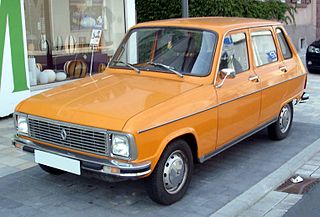
The Renault 6 or R6 is an economy C-segment small family car, manufactured and marketed by French automaker Renault from 1968 to 1986. The R6 entirely used the Renault 4's platform, initially including its small 845 cc (51.6 cu in) engine, and was technically near-identical, but its five-door hatchback body was larger and more modern. Visually it resembled the larger Renault 16, but distincly boxier.

The Peugeot 207 is a supermini car (B) that was designed and produced by the French automaker Peugeot from 2006 to 2014. It was presented at the Geneva Motor Show in 2006, and entered production in April 2006, as the successor to the Peugeot 206. It shares the same platform with the Citroën C3.

The Peugeot 304 is a small family car manufactured and marketed by the French manufacturer Peugeot from 1969 to 1980.

The PSA X engine is a family of internal combustion engines used in Citroën, Peugeot, Talbot and Renault automobiles. The X family was mainly used in superminis and the entry level models of midsize vehicles. It was designed and manufactured by the company "Française de Mécanique", a joint venture created by Peugeot and Renault in 1969, and built in Douvrin in northern France. It is commonly called the "Suitcase" engine, the "Douvrin" nickname being commonly used for the bigger 2.0-2.2 liter J-Type engine, which was also built in Douvrin.

The Peugeot 308 is a small family car produced by French automobile manufacturer Peugeot. It was unveiled in June 2007, and launched in September 2007. The 308 replaced the 307, and positioned below the 508 and above the smallest 208.
France was a pioneer in the automotive industry and is the 11th-largest automobile manufacturer in the world by 2015 unit production and the third-largest in Europe. It had consistently been the 4th-largest from the end of World War II up to 2000. It is 16% of sales of French manufactured products.



































